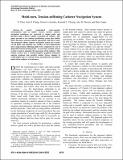Multi-turn, tension-stiffening catheter navigation system
Author(s)
Gupta, Rajiv; Chen, Yi; Chang, Jean H.; Greenlee, Alison S.; Cheung, Kenneth Chun-Wai; Slocum, Alexander H; ... Show more Show less
DownloadSlocum_Multi-turn tension.pdf (964.2Kb)
PUBLISHER_POLICY
Publisher Policy
Article is made available in accordance with the publisher's policy and may be subject to US copyright law. Please refer to the publisher's site for terms of use.
Terms of use
Metadata
Show full item recordAbstract
In poorly constrained extra-vascular environments such as hollow viscera, current catheter navigation techniques are restricted to simple paths and therefore limit a doctor's ability to position the catheter. This paper presents a new catheter positioning system that enables faster and more accurate catheter placement, with fewer scans. The proposed robotic catheter navigation system can execute curved paths and maintain any number of three-dimensional turns using tension stiffening guide-wires composed of a set of disposable friction-locking beads. An external, reusable control system is used to automate the movement of the catheter. This control system uses a custom-designed graphical kinematic analysis program that predicts contact forces, changes in conformation due to external forces, tip deflection and failure modes of the catheter as it advances.
Date issued
2010-05Department
Massachusetts Institute of Technology. Center for Bits and Atoms; Massachusetts Institute of Technology. Department of Mechanical Engineering; Program in Media Arts and Sciences (Massachusetts Institute of Technology)Journal
Proceedings of the 2010 IEEE International Conference on Robotics and Automation
Publisher
Institute of Electrical and Electronics Engineers (IEEE)
Citation
Yi Chen, Jean H Chang, Alison S Greenlee, Kenneth C Cheung, Alex H Slocum, and Rajiv Gupta. Multi-turn, Tension-stiffening Catheter Navigation System. In 2010 IEEE International Conference on Robotics and Automation, 5570-5575. Institute of Electrical and Electronics Engineers, 2010. © Copyright 2010 IEEE
Version: Final published version
ISBN
978-1-4244-5038-1